Nicola Cornick's Blog, page 33
March 25, 2011
Visiting Cards
In the nineteenth century a complicated system developed regarding how visiting cards should be left and folded when ladies and gentlemen of quality paid a social call. If the call was  a simple visit, the right hand upper corner of the card would be folded down. If the card was by nature of congratulations then the top left hand corner would be folded down and if it was a visit of condolence then the bottom left hand corner would be folded up.
a simple visit, the right hand upper corner of the card would be folded down. If the card was by nature of congratulations then the top left hand corner would be folded down and if it was a visit of condolence then the bottom left hand corner would be folded up.
So far, so straightforward. But when a person went abroad or was going to be absent from town for a while and did not wish to take leave of their acquaintance in person they also left a card. This time they would add an inscription: the letters PPC – pour prendre conge, or PDA – pour dire adieu. In each case the letters would be written in ink, in capitals, in the left lower corner. In the Victorian period, to receive such 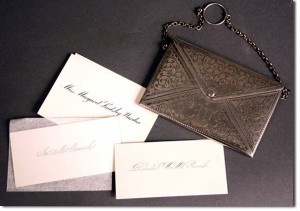 a card within an envelope generally meant that communication between the two parties was at an end. There were, however, three exceptions to the envelope rule (of course!) One was when a card was send in congratulation to a newly married couple, a second when the card was sent in reply to a wedding invitation and sent by someone who was absent from their usual home, and finally if the sender was leaving a PDA or a PPC card. With so many rules to navigate I can't help but feel it might just have been easier to see your acquaintance and pass the message on verbally!
a card within an envelope generally meant that communication between the two parties was at an end. There were, however, three exceptions to the envelope rule (of course!) One was when a card was send in congratulation to a newly married couple, a second when the card was sent in reply to a wedding invitation and sent by someone who was absent from their usual home, and finally if the sender was leaving a PDA or a PPC card. With so many rules to navigate I can't help but feel it might just have been easier to see your acquaintance and pass the message on verbally!
The Jane Austen Centre's online magazine has an excellent article about calling cards here.
©2011 Nicola Cornick. All Rights Reserved.
.March 23, 2011
Ten Uses For Old Telephone Boxes!
A couple of years ago when British Telecom decommissioned the public telephone box in our village, we had a discussion about what to do with it. Given that we are a relatively  isolated rural community with few facilities and that we are also a bunch of avid readers, the outcome was probably inevitable. Yes, we turned it into a library. Here it is!
isolated rural community with few facilities and that we are also a bunch of avid readers, the outcome was probably inevitable. Yes, we turned it into a library. Here it is!
Very soon the box filled up with copies of everything from Herodotus to Dick Francis, Cornwell to Cornick. Finding a copy of my own book Kidnapped there was was a rather odd experience. "Oh I see," I said huffily to my dh. "Someone has given my book away to the library!" "Someone liked it enough to want to share it," he said soothingly. Somebody else borrowed it and it never came back. There are no library fines or set borrowing periods so it is turning into a book swap as well as a borrowing service. But the stock levels remain pretty high.
Now we need some new shelves because our collection is growing. We've also started to write recommendations on the white board. "If you enjoyed Elizabeth Chadwick's fabulous historical "To Defy a King" then you might enjoy Susan Fraser King's breathtaking novel "Queen Hereafter." That sort of thing. There are a lot of fans of historicals around here. And the great thing is that we then go off and buy more books by new-to-us authors so it's proving to be a good way of stimulating both reading and book-buying in this area. It's even feeding into the local book group.
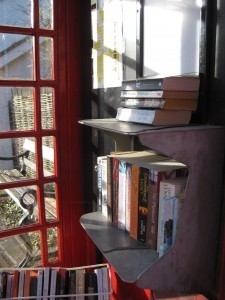 Our experience with our phone box led me to wonder what other imaginative ideas people had come up with when their phone boxes were decomissioned. I've come across lots of ideas: Art gallery, tourist information point, poetry reading centre, and a phone box featuring a mannequin dressed as a regularly changing seasonal, historical or fictitious character suggested by the children of the local primary school! Someone even turned theirs into a public toilet, something which many villages lack and need, especially if they are in a tourist area. (Or, to quote my dh again: "Sadly a lot of people used phone boxes for that purpose anyway so they might as well turn it into an official loo!")
Our experience with our phone box led me to wonder what other imaginative ideas people had come up with when their phone boxes were decomissioned. I've come across lots of ideas: Art gallery, tourist information point, poetry reading centre, and a phone box featuring a mannequin dressed as a regularly changing seasonal, historical or fictitious character suggested by the children of the local primary school! Someone even turned theirs into a public toilet, something which many villages lack and need, especially if they are in a tourist area. (Or, to quote my dh again: "Sadly a lot of people used phone boxes for that purpose anyway so they might as well turn it into an official loo!")
Now the phone box in the next village is available for conversion so we are looking for ideas for what to do with that one…
©2011 Nicola Cornick. All Rights Reserved.
.March 21, 2011
Winners!
Today when I asked Monty the Dog to choose the winner of the Dead Hot or Not discussion he grabbed two biscuits at once which means there are two prizewinners, Carrie and Laura  T. It's no wonder Monty is looking so pleased with himself! Both Carrie and Laura win copies of Unmasked. Congratulations to them and thank you for all the suggestions of hot historical guys and girls. This debate was a lot of fun!
T. It's no wonder Monty is looking so pleased with himself! Both Carrie and Laura win copies of Unmasked. Congratulations to them and thank you for all the suggestions of hot historical guys and girls. This debate was a lot of fun!
©2011 Nicola Cornick. All Rights Reserved.
.March 19, 2011
Dead Hot or Not?
This morning I have been inspired by a visit to the utterly wonderful blog Bangable Dudes in History. Check it out for some hot historical boys (and girls). Okay so some of them are of  dubious moral virtue – Stalin, anyone? – but let's not allow that to spoil things. I can see Stalin was a good looker in his youth. A lot of it is personal taste, of course. The picture of George VI didn't work for me because of an excess of facial hair and I've never been a fan of Edward VIII's girly look. But I LOVE the idea and the pie charts are superb.
dubious moral virtue – Stalin, anyone? – but let's not allow that to spoil things. I can see Stalin was a good looker in his youth. A lot of it is personal taste, of course. The picture of George VI didn't work for me because of an excess of facial hair and I've never been a fan of Edward VIII's girly look. But I LOVE the idea and the pie charts are superb.
I'm sure I have run a "nominate your own hot historical hero/heroine" blog piece before but it never hurts to repeat a fun exercise. Naturally when the phrase hot or not is mentioned my thoughts immediately turn to… Well, not William Craven for a change, but his great friend and comrade Prince Rupert of the Rhine. If Megan at BDIH was doing a pie chart for Rupert she might point out that he brutally sacked a few towns during the 30 Years War, he had a penchant for actresses and he trepanned his own head.
Now I'm asking you to nominate your own dead hot historical hero or heroine. Please share! I'm offering a copy of Unmasked to the first name drawn out of the hat on Monday.
©2011 Nicola Cornick. All Rights Reserved.
.March 17, 2011
Amazing Maze!
A few years ago I spent a memorable hour completely lost in the maze at Longleat House. I'm not sure of the precise moment when my enjoyment at wandering amongst the yew 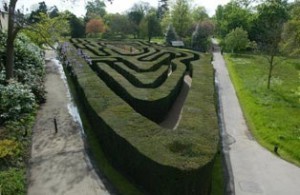 hedges turned to frustration that I could not find my way to the centre, and from there to genuine panic that I would be stuck in the maze until the sun set. (I assumed that someone would come round to show desperate visitors the way out, but perhaps we would have been doomed to wander forever.)
hedges turned to frustration that I could not find my way to the centre, and from there to genuine panic that I would be stuck in the maze until the sun set. (I assumed that someone would come round to show desperate visitors the way out, but perhaps we would have been doomed to wander forever.)
Despite that slightly nerve-wracking experience at Longleat I have always been fascinated by mazes and labyrinths and was interested to read that labyrinths originated almost 4,000 years ago. Mazes, of course, have multiple pathway choices whereas labyrinths have only a single route, originally thought to be a path for sacred dances. Labyrinths have been found in Bronze Age settlements along the Atlantic and Mediterranean shores, in medieval churches and now all around the world.
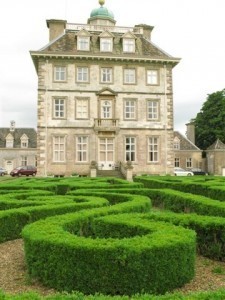 Interestingly there is a link between the medieval labyrinths and the showpiece Renaissance and Restoration parterres with their turf labyrinths or their low box hedging. A rather pretty example of this exists at Ashdown where the box was seen as the perfect complement to a hunting lodge (pictured). These were for decoration; there was little chance of being trapped inside one. However in the late 17th and 18th centuries the parterres developed into the first puzzle mazes with their hedge-lined paths. At Hampton Court Palace there is Britain's oldest surviving hedge maze with almost a kilometre of winding paths. This was planted more than 300 years ago for King William III and was originally created with hornbeam that was later replaced with yew. During its long history the Hampton Court maze has been patched up and repaired with other trees, which is rather charming. There's a picture of the Hampton Court maze at the top.
Interestingly there is a link between the medieval labyrinths and the showpiece Renaissance and Restoration parterres with their turf labyrinths or their low box hedging. A rather pretty example of this exists at Ashdown where the box was seen as the perfect complement to a hunting lodge (pictured). These were for decoration; there was little chance of being trapped inside one. However in the late 17th and 18th centuries the parterres developed into the first puzzle mazes with their hedge-lined paths. At Hampton Court Palace there is Britain's oldest surviving hedge maze with almost a kilometre of winding paths. This was planted more than 300 years ago for King William III and was originally created with hornbeam that was later replaced with yew. During its long history the Hampton Court maze has been patched up and repaired with other trees, which is rather charming. There's a picture of the Hampton Court maze at the top.
My interest in mazes, and possibly the memory of that experience at Longleat, came out quite unconsciously when I was writing Mistress by Midnight. It is in the maze at Starcross Hall that Garrick, the hero, finds his wife Kitty with her lover Stephen Fenner. Something of the mysterious quality, the danger and menace of mazes as well as their beauty came out in that scene.
Do you enjoy labyrinths and mazes? Have you ever been caught in one?
©2011 Nicola Cornick. All Rights Reserved.
.March 16, 2011
And The Winner Is…
Angie! Congratulations, Angie, on winning the Lord Greville's Captive audiobook! Please could you email me at ncornick(at)madasafish.com with your mailing details so I can put Lord Greville  straight in the post to you. Thank you to everyone for such an interesting discussion on the merits and drawbacks of audio books, and for reminding us that Richard Armitage is always there to read Goergette Heyer's Sylvester to us if we need him!
straight in the post to you. Thank you to everyone for such an interesting discussion on the merits and drawbacks of audio books, and for reminding us that Richard Armitage is always there to read Goergette Heyer's Sylvester to us if we need him!
©2011 Nicola Cornick. All Rights Reserved.
.March 14, 2011
Giveaway – Lord Greville's Captive!
There are so many things that I would like to blog about today that I actually can't decide which to choose. This is really weird – I've picked and discarded a number of topics: Mary 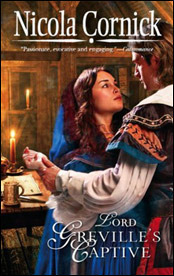 Shelley's Frankenstein, the Cornish National Anthem, the history of a few nursery rhymes… The only thing I do know is that I've been clearing out my stock of spare books and found an audio book of Lord Greville's Captive. It's the only one of my books that was ever turned into an audio book (it was serialised on the radio as well – with an 18 certificate!) and was famously responsible for me very nearly driving into the back of another car when I was listening to it and we got to the bondage scene… Yes it is hot and listening to Simon Poland reading it only made it hotter. And now I'd like to share that experience by giving away a copy – but only with the proviso that you have been warned not to listen to it whilst driving or operating machinery.
Shelley's Frankenstein, the Cornish National Anthem, the history of a few nursery rhymes… The only thing I do know is that I've been clearing out my stock of spare books and found an audio book of Lord Greville's Captive. It's the only one of my books that was ever turned into an audio book (it was serialised on the radio as well – with an 18 certificate!) and was famously responsible for me very nearly driving into the back of another car when I was listening to it and we got to the bondage scene… Yes it is hot and listening to Simon Poland reading it only made it hotter. And now I'd like to share that experience by giving away a copy – but only with the proviso that you have been warned not to listen to it whilst driving or operating machinery.
So – the discussion question. Are you a fan of audio books? Some people find they help them sleep, others not so much, but of course that depends on the book. Have you had any amusing, compromising or downright dangerous experiences whilst listening to an audio book? Or indeed reading any book? (A friend of mine reports that reading a romance book saved her when her house was on fire because it was so unputdownable she was still awake and reading at 2am when the fire broke out!)
I'll send a copy of my dangerous audio book to the first commenter whose name is drawn out of the hat on Wednesday!
©2011 Nicola Cornick. All Rights Reserved.
.March 11, 2011
Regency Gaming Table
Here is a thing of beauty! This Regency gaming table went on sale as part of the contents of Ashdown House, auctioned off at 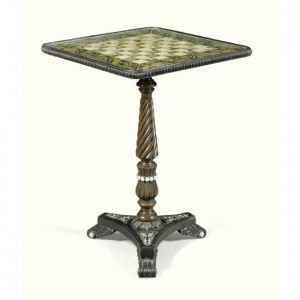 Sothebys last year. As you can see from the chequerboard top, it was designed for games such as chess or draughts but could also be used for cards games like faro, piquet and whist. If you click on the picture on the left you will see that the squares contain pictures of country scenes and that the surround also shows leaves and rosettes and flowers. It's exquisite!
Sothebys last year. As you can see from the chequerboard top, it was designed for games such as chess or draughts but could also be used for cards games like faro, piquet and whist. If you click on the picture on the left you will see that the squares contain pictures of country scenes and that the surround also shows leaves and rosettes and flowers. It's exquisite!
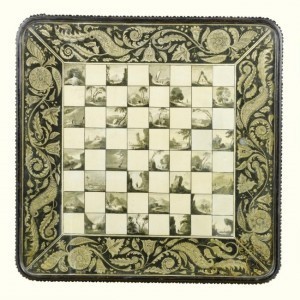 Many gaming tables I have seen are made of wood, mahogany being the most popular choice, with brass decoration and rosewood veneers. They could double up to serve as a tea table, a writing desk or even a needlework table. Some of them open up so that the cards – or needlework – can be stored in the space beneath. I've seldom seen any as pretty as this one, though, and would gladly give it house room. I hope you like it too!
Many gaming tables I have seen are made of wood, mahogany being the most popular choice, with brass decoration and rosewood veneers. They could double up to serve as a tea table, a writing desk or even a needlework table. Some of them open up so that the cards – or needlework – can be stored in the space beneath. I've seldom seen any as pretty as this one, though, and would gladly give it house room. I hope you like it too!
©2011 Nicola Cornick. All Rights Reserved.
.March 9, 2011
Gardens of Pleasure
Spring is sprung here in the UK, there are lambs in the fields and wood anemones growing in my lawn and the sun is shining!
Today I am blogging over at the Word Wenches about the Picturesque Landscapes of the late 18th and early 19th century and the pleasure gardens at Old Wardour Castle which I visited recently. Come and join in the chat – and share with us those little picturesque touches with which you decorate your own garden, back yard or window box!
©2011 Nicola Cornick. All Rights Reserved.
.March 7, 2011
Experiencing the Regency
Today I am blogging over at the UK Regency Authors' Blog and asking "Which events of the Regency period would you have liked to experience at first hand?" 
©2011 Nicola Cornick. All Rights Reserved.
.


